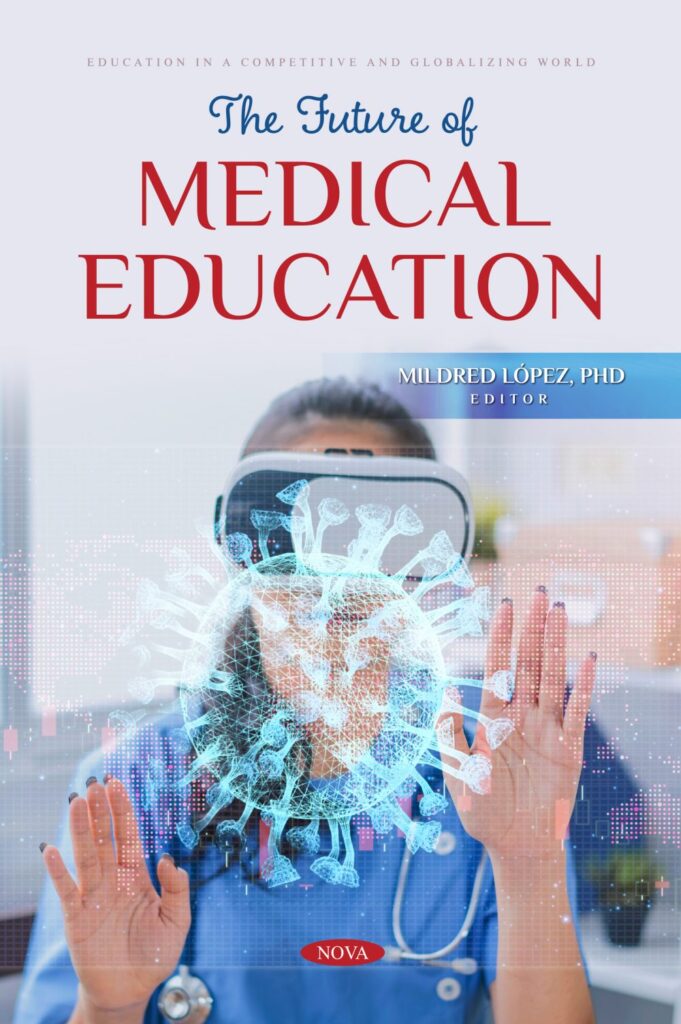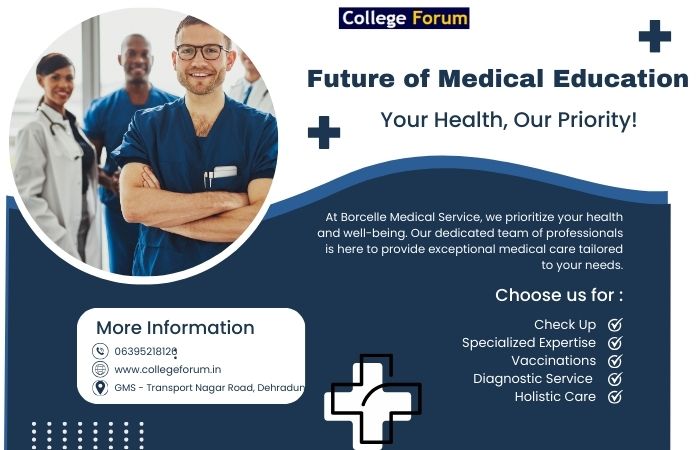Introduction
Medical education is rapidly changing, given the integration of technology, a move towards patient-centered care, and increased need for the health provider. Indeed, the future of medical education is going to change dramatically. Medicine teaching and training methods are slowly being replaced by new ways aiming to give the next doctors, nurses, and allied healthcare professionals much more clinically relevant abilities. We discuss key emerging trends in innovations shaping the future of medical education in this paper.
Technology is Becoming Increasingly Important in Medical Education
Technology is probably the most significant trend shaping the future of medical education. Contemporary medical students are exposed to varied technological tools that enhance their learning experiences and adequately prepare them for real-world, clinical practice. From virtual simulations to AI powered platforms, technology is playing a core role in the evolving medical education.

1. Virtual Reality (VR) and Augmented Reality (AR) in Medical Training
There are continued observations about increased usage of virtual reality (VR) and augmented reality (AR) within medical schools. With these technologies, students can exercise practicing surgical procedures, learn anatomy, or even practice making diagnoses on patients. These technologies allow for an immersive experience-the closest to the natural truth that one can hope for with any educational technique. This trend will likely continue as more institutions of medicine incorporate this tool into their curricula.
2. AI-Powered Educational Platforms
AI is changing how medical students learn. Using AI-based learning platforms, AI enables personalized experiences through customization of content according to a student’s progress, strength, or weaknesses. Through predictive analytics, educators will now be able to project which students need more help and in what way. In the future of medical education, AI will play a significant role in perfecting training for every student as per their individual needs.
Emergence of Online and Blended Learning Models
The COVID-19 pandemic has accelerated online education everywhere. Of course, online learning has been on the rise even in medical education.
More importantly, the growing use of online learning and blended learning models has emerged in this health-related field.
1. Online Medicine Courses and Certifications
The online courses thus open doorways to students who would otherwise not be able to attend a traditional brick and mortar institution. The flexibility offered allows the student to study at his own pace while refreshing his know-how with the latest medical knowledge. Online education will remain at the heart of medical education in the future, especially when it comes to CME and professional development.
2. Blended Learning: Hybrid Model
Blended learning brings together the best of two worlds: old school, in-person training and online education. This model will enable students to enjoy the hands-on clinical experience while leveraging the advantages of digital learning. Many medical schools, especially now, are adopting the blended learning model to ensure that their students receive all-rounded education, readying them to face all the complexities modern healthcare deals with.
Simulation-based learning: A game-changer
Simulation-based learning is the other very innovative design that will shape the future of medical education. This type of learning will utilize highly advanced simulators to portray real-life medical situations. Here, students can try out critical procedures in a situation where there would be no risk to patients.

1. Mannequins of high fidelity
Such high-fidelity mannequins have become highly prevalent in medical education. With this mannequin, a wide range of simulated emergencies can be performed including cardiac arrest, respiratory failure, or traumatic injury. Students can conduct procedures, deliver treatments, and take end decisions in real time. This hands-on approach is meant to enhance learning through immediate feedback where one improves his or her skills before working with actual patients.
2. Virtual patients
Besides mannequins, virtual patients are the new utility in the world of medical education. Computer-generated patients can portray a wide spectrum of medical conditions whereby students can sharpen their skills on diagnosis and treatment. Interactive experience through virtual patients is both interesting and educational. As time keeps moving into the future of medical education, virtual patients will play an ever greater role in training the healthcare professionals.
Interdisciplinary Learning and Collaboration
The health care of the future is interdisciplinary, and so is the future of medical education. Medical professionals are not anymore working as silos. Instead, they are working altogether with all kinds of other providers of health care, including nurses, pharmacists, physical therapists, and social workers.
Team-Based Learning
Teaching in medical schools puts much emphasis on team-based learning wherein students from diverse health disciplines collaborate in the solving of challenging clinical problems. This is similar to the world’s real health care situations; where teamwork is fundamental in healthcare delivery for better quality service for the patient. By emphasizing teamwork in the preparation of students for health care delivery, medical education is giving an opportunity to prepare them for the working nature of health care delivery nowadays.
2. Problem-Based Learning
Problem-based learning is yet another trend to be realized in the future of medical education. It allows students to form teams to solve real-life medical cases rather than depending on lectures. Such a pattern fosters critical thinking, problem-solving, and effective communication-all highly necessary skills to thrive in a career in health.
Globalization of Medical Education
Today, the future of medical education is fast becoming global. Having progressed in technology with greater connectivity, more resources, courses, and collaborations worldwide are available to medical students and professionals.
1. International Collaboration and Exchange Programs
Medical schools are now increasingly striving to offer such experiences in international collaboration, such as exchange programs and global health initiatives. This type of program exposes students to diverse healthcare systems, practices, and difficulties. Given this rapid globalization, an increasing ability to understand and operate within diverse healthcare settings will be extremely important to future medical professionals.
2. Global Health Initiatives
There is rising interest in global health in medical education. Many schools are now offering courses with specializations in global health to prepare students to address health challenges on a global level. In fact, this trend is especially important today with crises such as pandemics and the increased incidence of non-communicable diseases.
Future of Medical Curriculum: Adaptive and Student-Centric
The usual medical curriculum does not easily fit the needs of these students as it is very rigid. Instead, the near future of medical education is expecting to be more flexible and focused on the needs of the students.
1. Personalized Learning Tracks
The strengths and interests of students of medicine are unique, and in approaching the future of education, many institutions are going to offer personalized learning paths through which students are able to tailor their education to fit their career goals. This could include specialized training in surgery, pediatrics, or radiology, allowing focused areas of interest earlier in their education.
2. Competency-Based Education
Other inventions shaping the future of medical education include competency-based education, commonly known as CBE. Unlike the practice of old days, such as tests and grades, successful progress in CBE is measured in terms of students’ ability to demonstrate their competencies in specific areas of skills and knowledge. Consequently, it sets them well for the practices that will be anticipated when such students graduate from medical school.
Conclusion
With regards to technology, collaboration, global health, and personalized learning, the medical education future is surely sure to have brighter days ahead of it. Healthcare is a continuous process, and so too are the ways in which future medical professionals should be taught. Medical education, therefore, is better equipping students for the challenges and opportunities they will face in their careers embracing these trends and innovations. This will also mean virtual simulations, AI-powered platforms, or team-based learning, among other changes set to revolutionize the future of medical education on training the next generation of healthcare providers.
FAQs
1. The influence of technology on the future of medical education Technology, including virtual reality, AI, and simulation-based learning, is changing the future of medical education by keeping it more interactive, personalized, and easy to access.
2. What is blended learning in medical education? Blended learning is a learning system that involves both offline and online learning. It is a method of learning that offers students flexibility with easy access to an enhanced learning experience.
3. Why is interprofessional learning relevant to medical education? Interprofessional learning promotes collaboration among various healthcare professionals and reflects the real-world view of health care and improves care delivery.
4. How does global health feature in the future of medical education? Global health projects and international partnerships become important, preparing students to address healthcare challenges worldwide.
5. Competency-based education what is it in medical education? The essence of competency-based education is that students demonstrate mastery of knowledge before they leave the medical school and enter into clinical practice.

